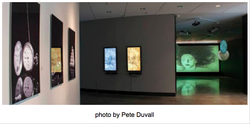
In a darkened gallery a three-part video tells a story that is open to interpretation. It transcends the everyday experience of linear time with a dream state that compresses experience and memory into simultaneous vignettes. Like the b & w format of early television, the settings and clothing styles in these b & w videos appear to date from around 1950. A woman is seen walking through a deserted amusement park. As she walks towards you, a ball bounces from right to left and leads you to a second screen in which you see the woman against a carousel. A man stands in the foreground, checking his watch. This man (the artist? ) and the ball appear in each video. In the third and last screen his image is repeated along with that of an older man, the two stepping from left to right in a dance-like motion. The work suggests a narrative, a sense of continuity from before to after, but the viewer must put the pieces together -- and each person’s story may differ.
“Sleepwalker’s” main installation consists of a large screen showing a restlessly sleeping woman. Images of her overlap, collapsing time and disrupting the sequence as she tosses and turns, apparently dreaming. Circles of glass, suspended from the ceiling in the darkened room, display snippets of her dreams: once again there is a ferris wheel; a man dials a telephone and mouths the word “hello”; a woman’s hand writes on a blackboard in perfect cursive, the kind no one learns anymore. The penmanship lesson perhaps delivers the key to the dream’s meaning. -Nancy Ungar
 RSS Feed
RSS Feed